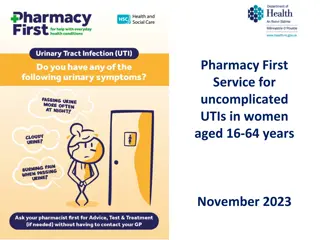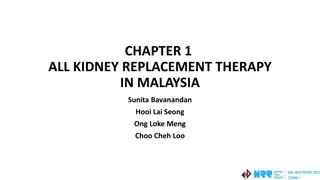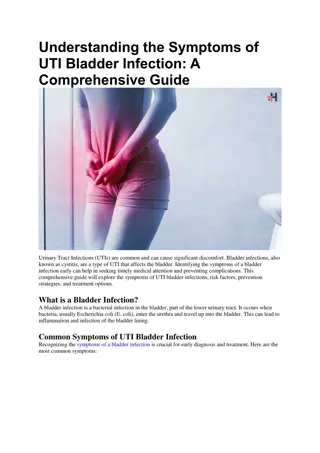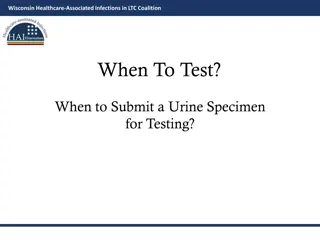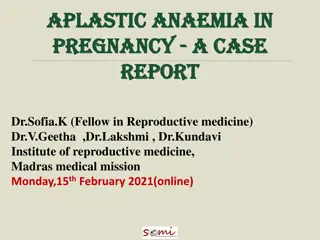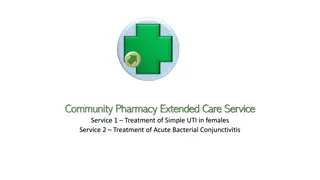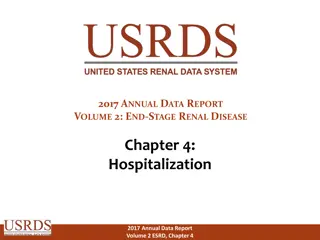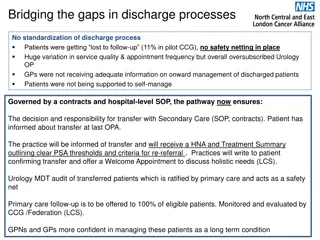Approach to Patients with UTI: Case Scenario & Objectives
A 25-year-old woman presents with UTI symptoms post-marriage. Explore UTI definition, DD, lower & upper UTI differentiation, and initial management plan for acute cystitis. Clinical tips and common infections discussed.
Download Presentation

Please find below an Image/Link to download the presentation.
The content on the website is provided AS IS for your information and personal use only. It may not be sold, licensed, or shared on other websites without obtaining consent from the author.If you encounter any issues during the download, it is possible that the publisher has removed the file from their server.
You are allowed to download the files provided on this website for personal or commercial use, subject to the condition that they are used lawfully. All files are the property of their respective owners.
The content on the website is provided AS IS for your information and personal use only. It may not be sold, licensed, or shared on other websites without obtaining consent from the author.
E N D
Presentation Transcript
Case scenario A 25-year-old lady, who works as a teacher in a secondary school, has presented to the clinic today with the complaint of painful and burning micturition, lower abdominal pain and increased frequency of urination. These complaints initiated for last 2 days. She has got married just a week ago. Bowel movements are normal. No history of fever, chills or rigor. On examination: She look well, not in pain, not pale or jaundiced. Temperature is 37.2 0C. Systematic examination revealed normal, apart from tenderness in the lower abdomen in the pubic area. Summarize the case
Objectives: Identify Differential Diagnosis DD of a case of UTI Differentiate between the upper and lower UTI. Discuss briefly about the acute cystitis (lower tract UTI) and honeymoon cystitis. Discuss briefly about pyelonephritis (Upper UTI). Investigate appropriately a patient with UTI. Advice initial management plan for a patient with acute cystitis. Identify preventive measures for acute cystitis.
Definition of UTI A urinary tract infection (UTI) is an infection of the kidneys, bladder, or urethra. Infectious cystitis is the most common type of UTI, which is caused by a bacterial infection of the bladder. Pyelonephritis is an infection of the kidney that often occurs via bacterial ascent. Urethritis is an infection causing an inflammation of the urethra.
DD lower urinary tract infection (LUTI). upper urinary tract infection (UUTI). Urethritis. Urinary tract stones or foreign bodies. Sexually transmitted diseases (STDs). Vulvovaginitis. Lithium and heavy metal toxicity.
Clinical tips Females > males UTIs in male STDs Old females > young females Rare in children ?????
Lower and Upper UTI Lower urinary tract infection (LUTI): Symptoms suggestive of cystitis (dysuria or frequency without fever, chills or back pain). Upper urinary tract infection (UUTI): Symptoms suggestive of pyelonephritis (loin pain, flank tenderness, fever, rigors or other manifestations of systemic inflammatory response).
Urinary tract Infection: UTI most common bacterial infection. Women are more likely to experience UTI than men. Up to 50% of women had UTI at some time during their life. Recurrent infections are serious. It can cause severe renal disease even end-stage renal failure.
Urinary tract Infection (Cont..) The condition is rare in boys and young men. Invasion and multiplication of microorganisms in UT. Microorganisms reach urinary tract via either: The urethra Ascending infection or Bloodstream from a distant source Hematogenous .
Risk Factors: 1. Aging 2. Females: short urethra, having sexual intercourse, use of contraceptives . 3. Males: prostatic hypertrophy, bacterial prostatitis . 4. Urinary tract obstruction: tumor .
Risk Factors: Sexual activity, Spermicide use Spermicides, Post-menopause The absence of oestrogen (consistent with urogenital atrophy, vaginal atrophy), Positive family history of UTIs, History of recurrent UTI, Presence of a foreign body.
Classification Uncomplicated or complicated. - Uncomplicated UTIs include acute cystitis occurring in otherwise healthy, non-pregnant women without functional or anatomical urinary tract abnormalities. - Complicated UTIs include infections in patients with functional or structural impairments that reduce the efficacy of antimicrobial therapy. - The involvement of the kidneys (pyelonephritis) or UTIs occurring in pregnancy are also considered complicated UTIs.
Classification - Acute UTIs are infections causing acute symptoms in the presence of infected urine. - Recurrent UTI is defined as two separate culture- proven episodes of acute UTIs and associated symptoms within 6 months, or more than three UTIs in 12 months.
The Risk Factors For Acute Cystitis In Female Short urethra. Age. sexual activity. Pregnancy. Contraceptive pills. Diabetes mellitus. Poor hygiene. Wipe from back to front.
Acute cystitis: Acute inflammatory signs are present of the inner lining of the bladder and it becomes red, congested and swollen. It s most common by E.coli (75-95%) . It cause by Proteus, Klebsiella but less common. Women have a higher incidence of infection.
Cystitis: Un- Complicated Sign and symptoms complicate d (simple) cystitis Infections in patients with functional or structural abnormalities that reduce the efficacy of antimicrobial therapy. cystitis Healthy, non-pregnant women without functional or anatomical urinary tract abnormalities. Suprapubic pain Dysuria If in male patients or in pregnant women, also considered as complicated. Hesitancy No fever, nausea, vomiting or flank pain. Urinary frequency and urgency If the kidney was involved (pyelonephritis).
Table 1 Organism Approximate frequency (%) 68% E coli and other coliforms Proteus mirabilis 12% Staph, saprophyticus. 10% Enterococcus faecalis 6% Klebsiella aerogenes 4%
Honeymoon cystitis It s a term for UTI that often occurs after Sexual activity. Sexual activity can push infecting bacteria Into the urethra resulting in an infection . Women with a diaphragm placed for birth control are at a higher risk for UTIs .
Complicated UTI DM Pregnancy kidney transplant stones anatomic abnormality catheterization recent antibiotics recent hospitalization UTI in males
Pyelonephritis: Severe infectious inflammatory disease of the renal parenchyma, calyces and pelvis. Signs and symptoms: Fever (> 38 C) and chills. Unilateral or bilateral flank or angle pain and tenderness. Nausea and/or vomiting. Anorexia.
Pyelonephritis Acute Sudden development of kidney infection. pyelonephritis long standing infection that doesn't clear and can result in kidney scarring . Occurs only in patients with major anatomic abnormalities . Chronic pyelonephritis chronic pyelonephritis that occur in obstruction due to infected or renal stones. Affected patients usually have massive destruction of the kidney .( confused with renal malignancy ) Xanthogranulomat ous pyelonephritis Recurrent pyelonephritis 2 infections in six months or 3 infections in one year.
Cystitis vs Pyelonephritis: Cystitis Pyelonephritis Site Lower UT Upper UT Fever NO Yes Pain suprapubic flank
Laboratory: Dipstick urinalysis Microscopic urinalysis (clean catch midstream specimen). Urine Culture
Urine dipstick Perform a urine dipstick test as the first diagnostic test in women aged under 65 years with urinary tract symptoms where they have: - Only 1 of the 3 key signs or symptoms (dysuria, nocturia, or cloudy-looking urine, OR - None of the 3 key signs or symptoms but other severe symptoms of urgency, frequency, visible haematuria, or suprapubic tenderness).
Laboratory: Dipstick urinalysis 1. Positive leukocyte esterase. Can detect bacteria equalent to 100,000 colony forming unit/ml 2. Positive Nitrites. 3. Positive RBCs.
Work up(urine dipstick) Presence of leukocyte esterase (an enzyme released by leukocytes, reflecting pyuria) Nitrite (reflecting the presence of Enterobacteriaceae which convert urinary nitrate to nitrite) Positive for RBCs
Cont ..Laboratory: Microscopic urinalysis (clean catch midstream specimen). 1. Look for pyuria, bacteriuria, and leukocyte castes. 2. Hematuria and proteinuria may be present. Urine culture recommended in complicated and upper UTI
Urine culture: Should always be performed in: Men Suspected upper UTI, With complicating factors: Pregnancy Diabetes. It s not required for symptomatic lower UTI in non-pregnant women.
Indications for culture Has none of the 3 key diagnostic symptoms but has other urinary symptoms, and the urine has positive leukocytes and negative nitrites. Is pregnant Is aged over 65 years and is symptomatic and is being started on antibiotics for a UTI Has suspected sepsis or pyelonephritis Has persistent symptoms or antibiotic treatment has failed Has recurrent UTIs (2 in 6 months or 3 in 12 months) Has a urinary catheter and will receive antibiotics for a UTI Has a risk of antimicrobial resistance.
Criteria for diagnosis 3 key signs or symptoms (dysuria, nocturia, or cloudy-looking urine). Only 1 of the 3 key signs or symptoms plus positive nitrites and leuco-esterase in urine dipstick. Only 1 of the 3 key signs or symptoms plus pus cells in microscopic urine analysis. Symptoms plus growth in urine culture.
Blood culture: Only indicated in ill-patient and if urosepsis is suspected.
Role of imaging Plain x-ray Ultrasonography CT Intravenous pyelography (IVP) Micturating cystourethrography Cystoscopy In complicated UTI Renal stones or obstruction Hydronephrosis or abscess Poor bladder emptying Illness despite 3 days of treatment Urinary tract congenital anomalies Visualization for biopsy
Management Non-pregnant women <65 Ys without a catheter. - Give immediate antibiotics for women with severe symptoms who have: 2 or 3 of the key diagnostic signs and symptoms for UTI (dysuria, new nocturia, cloudy-looking urine) OR 1 key diagnostic sign or symptom AND -A urine dipstick positive for nitrite OR -A urine dipstick positive for leukocytes and negative for nitrite OR -A urine dipstick positive for both leukocytes and red blood cells. Watch and wait and provide a back-up prescription for antibiotics for women with mild symptoms.
SIGN guideline recommends considering NSAIDs as a first-line treatment in women aged under 65 with mild symptoms. This offers an alternative to antibiotics in order to reduce antibiotic prescribing. Consider and discuss with the patient the risks and benefits if considering this approach. Limit the duration to 3 days and ask the patient to make contact if the symptoms do not resolve or worsen in this time
Back-up prescriptions for women with acute uncomplicated UTI seem to be as effective as immediate prescriptions (measured by severity of symptoms, duration of symptoms, and time to reconsultation) and reduce the number of women using antibiotics. - Do not give immediate or back-up antibiotics to women with no key diagnostic signs or symptoms and a dipstick test negative for nitrites, leukocytes, and red blood cells. - Do not send a urine culture. Do not treat non-pregnant women who have asymptomatic bacteriuria
Choice of antibiotic Nitrofurantoin if estimated glomerular filtration rate (eGFR) 45 mL/minute Nitrofurantoin is effective against Escherichia coli , the most common causative pathogen in uncomplicated UTIs (70%-95% of patients) Trimethoprim if low risk of resistance Duration of treatment - NICE recommends a 3-day course.
Women 65 years (without a catheter). Give immediate antibiotics, ideally after sending urine for culture, for women aged 65 years with severe symptoms and a likely UTI. Watch and wait and give a back-up prescription for antibiotics, ideally after sending urine for culture, for women aged 65 years with mild symptoms and a likely UTI. For first-choice antibiotic, Nitrofurantoin (nitrofurantoin: 100 mg orally (modified release) twice daily; 50 mg orally (immediate release) four times daily). Trimethoprim if low risk of resistance (200 mg orally twice daily).
Pregnant women (without a catheter) Initial management Prescribe an immediate antibiotic, after sending urine for culture, for all pregnant women with symptoms of a UTI. First-choice antibiotic in women with symptoms of a UTI, Nitrofurantoin if eGFR 45 mL/minute. second-choice antibiotic, Amoxicillin Cefalexin - For women with asymptomatic bacteriuria prescribe nitrofurantoin, amoxicillin, or cefalexin. Duration of treatment is 7-days.
Women (any age) with a catheter Send a urine sample for culture and susceptibility testing, noting a suspected catheter-associated infection, before prescribing any antibiotic. Prescribe at least a 7-day course of antibiotics to ensure complete cure. - Nitrofurantoin - Trimethoprim if low risk of resistance. Pregnant women with catheter-associated UTI:- - Prescribe cefalexin. - For first-choice intravenous antibiotic, in patients who are vomiting, are unable to take oral antibiotics, or are severely unwell, prescribe cefuroxime
Special Circumstances Older women Need longer duration of antibiotics (7-10 days) In men of 15-50 years, incidence very low Risk factors: homosexuality, lack of circumcision Need 7-10 days duration In pregnancy Cephalexin 250/125mg 6-hourly. Amoxicillin 250mg 3 times daily. (Trimethoprim and Quinolons to be avoided)
Follow-up: Patients with acute cystitis or pyelonephritis who have persistent symptoms after 48 to 72 hours of appropriate antimicrobial therapy or recurrent symptoms within a few weeks of treatment Should have urine culture repeated and empiric treatment should be initiated with another antimicrobial agent.
Fluid intake of at least 2 L/day. Timed voiding (regular complete emptying of bladder). Good personal hygiene especially during sexual intercourse. Females, should wipe from front to back after voiding to prevent contaminating the urethra with bacteria from the anal area. Cranberry juice may be effective.
Prophylactic therapy: In recurrent infections Treatment for 6 12 months low-dose prophylaxis: Trimethoprim 100 mg, Co-Trimoxazole 480 mg, Cefalexin 125 mg at night)


